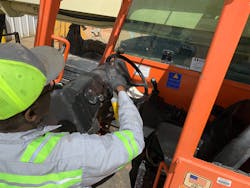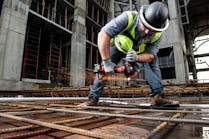Covid-19’s impact on the construction industry has forced businesses into taking unprecedented measures to protect their employees.
Although mainstream efforts such as social distancing and wearing personal protection equipment (PPE) are important, managers are finding that additional actions are necessary, such as daily health checks and disinfection.
Kokosing Construction screens employees on site before starting work. Screenings include questions about potential symptoms and a temperature reading. Employees check in at designated areas for screening.
“Our expectation is that they’ll take their temperature before they come to work,” says Carl Uhinck, equipment manager at Kokosing. “We don’t want them to show up if they have a fever. But we’ll provide daily readings regardless.”
Uhinck’s shop uses temperature strips and scannable thermometers. The strips are disposable and heat-sensitive, indicating the user’s temperature in under one minute.
“We prefer using the strips because you don’t have to handle anything,” says Uhinck. “You just give it to each worker, and they push it against their forehead. It will change color based on the temperature that is read.”
Watch an in-depth Zoom discussion here:
Personnel within the shop conducting screenings can also use a scannable thermometer to take temperatures. In some shops, scanners reach around a glass or plastic window when screening employees. The screener wears a mask, and their face stays behind a barrier at all times.
“Each team member has a designated area they go to,” says Uhinck. “They don’t pass through to anywhere else. That’s where we do the initial checks and questions.”
According to the Center for Disease Control and Prevention (CDC), employees with a temperature of 100.4 F or more should be sent home. The CDC also recommends screeners make a visual inspection of the employee for signs of illness, such as flushed cheeks.
“If someone is very symptomatic—has a fever, cough, and sore throat—we’ll ask them to do a 14-day quarantine,” says Luke Heldt, shop manager at Traylor Equipment. “But if their symptoms are minimal, we ask them to monitor their condition from home.”
If symptoms dissipate within three days, and at least seven days have passed since symptoms began, workers may return to the shop.
How to disinfect surfaces for coronavirus
CDC also says the coronavirus may remain on various surfaces for hours or days. It recommends disinfecting workstations and the inside of equipment cabs daily, sometimes multiple times. Most EPA-registered household disinfectants and diluted household bleach solutions are effective.
Some shops opt for a bleach cleaning solution. A designated worker sprays commonly touched surfaces in the shop every few hours.
To safely disinfect machines and spaces, workers across several shops wear gloves appropriate for the chemicals being used. At United Rentals, disinfecting ensures the safety of employees and customers.
“We have our technicians disinfect all high-touch surfaces,” says Taylor Abel, director of safety. “So if they’re going to deliver an aerial lift they would disinfect the knobs, the railings, the latches, and any other surface before they have to service it or pick it up.”
When the team delivers a machine, they also incorporate “last touch service.”
“This is standard when we drop equipment off in a customer location,” Abel says. “We will do one final disinfectant by spraying the equipment down.”
Uhinck’s shop assigns team members at the start, during, and end of a shift to disinfect all common tooling, shared maintenance machinery, and common areas throughout the shop. A cleaning service deep cleans the shop every two to four weeks, he says.
“We also have a disinfecting station [with disinfection materials] on each piece of equipment, so you can clean it off before you enter,” he says.
At General Equipment and Supplies, a technician who was considered “higher risk” contracted Covid-19. Higher-risk individuals are usually identified as older, or immunocompromised in some capacity.
“After he tested positive, we brought in a professional cleaning service,” said Jon Shilling, the dealership’s president. “They came in and sprayed down everything he came in contact with.”
Hiring professionals brings extra cleanliness. It also brings peace of mind to team members when you’re taking steps to ensure the environment is safe for work.
Common areas also require attention. This includes break areas, lunchrooms, locker rooms, tool rooms, and offices.
“Anything that’s multiple-use has to be cleaned and disinfected daily,” says Michael Brennan, CEM, CDMB Consultants, and Equipment Executive columnist for Construction Equipment. “And if they’re operating within multiple shifts to enforce social distancing, they should be disinfecting between shifts.”
Surfaces that cannot be cleaned should be isolated. This might include not only some contaminated machinery or equipment but also packaging such as cardboard.
Contactless parts deliveries also reduce the risk of contamination. Vendors leave a delivery at a doorstep, and move back to a distance greater than six feet away while virtually verifying receipt.
“We’ve even given UPS and FedEx people a dedicated drop off area to drop off packages outside the branch,” says Able. “And we’ve worked hard to ask our suppliers and partners to limit their personnel coming to the branch. Now they call ahead, and we’ve stopped visits where it isn’t important.”
Kokosing also adopted a no-signature policy to limit contact during deliveries. Now required vendors and suppliers wait for a call to drop something off if needed.
“We didn’t really know what we were dealing with early on,” says Uhinck. “So we turned off the ability to walk in and out right off the bat, and had no one come unless we reached out.”
The group also set up a Conex box, similar to a shipping container, outside of the facility.
“All delivery personnel can show up, drop off the parts, drop the invoice in, with no signature required,” Uhinck says. “We have contact numbers in case they have questions or concerns.”
New health and safety regulations have challenged essential workers around the country. Daily health checks are now part of the “new norm,” along with disinfection. As equipment managers continue to monitor the ongoing situation, these regulations may alter the way their staff works far into the future.
“I think at this point, given the gravity of the situation, the rules have developed in a very short period,” says Brennan. “Hopefully the end is near. We have to see how this unfolds over the next few months.”






